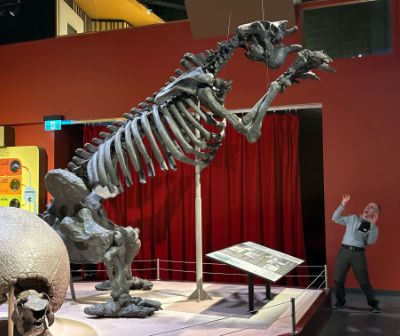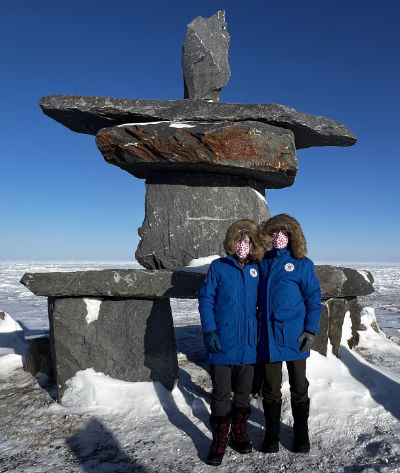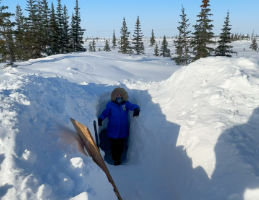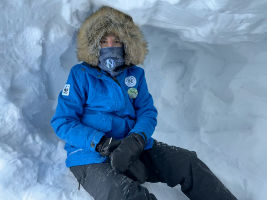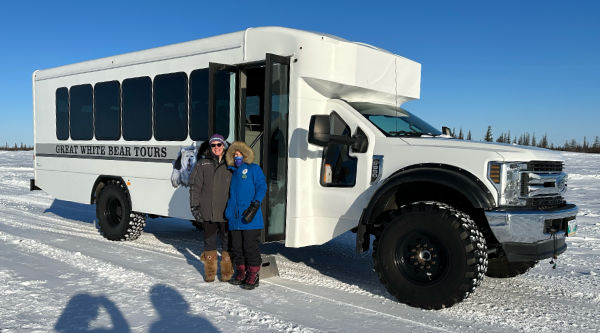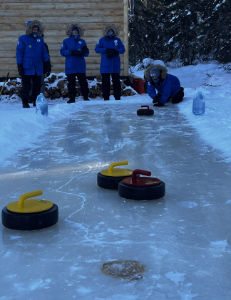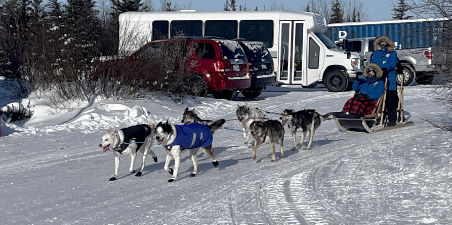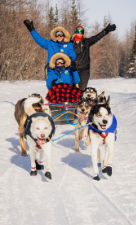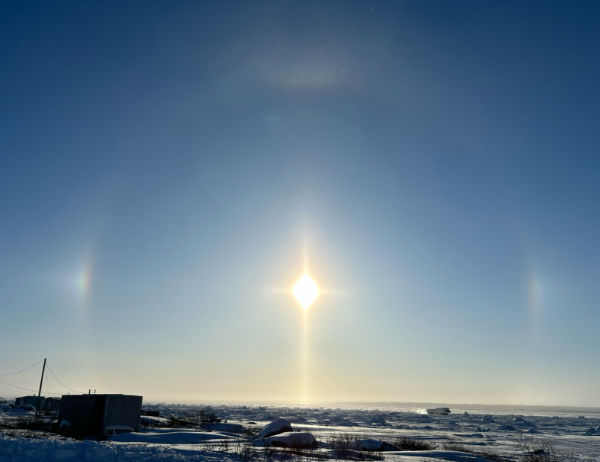|
Aurora Borealis Trip
Churchill, Manitoba
February, 2023
We took a trip to Churchill, Manitoba, in sub-arctic Canada, to see the aurora borealis (aka northern lights). We went in February to get dark skies with minimal chance of clouds. That worked great; we saw aurora all four nights. It was also very cold – the price you pay for clear skies – typically around -25° F, with wind chill taking it even lower. Churchill is well-known for polar bears, but this time of year they're 30 km out on the Hudson Bay ice hunting seals, nowhere near town.
Our tour started in Winnipeg, Manitoba. We scheduled our flight two days early to allow for travel delays and so we could spend some time seeing Winnipeg. We found some great local restaurants and spent a day at the Manitoba Museum, touring the exhibits and watching a couple of shows in the planetarium.
When we arrived in Churchill, our guide, Lianne, took photos of each of the tour participants in iconic locations. We all look a lot alike bundled up in matching parkas, but we could identify ourselves due to the distinctive face masks (hearts since it was February 14)!
After dinner, we bundled up and headed out to the viewing location for the evening. We got to see a beautiful aurora! It was interesting to see how it changed over the course of the evening. Its movement wasn't obvious, but it was noticeably different as time progressed.
With proper clothing, staying comfortable in -25° F temperatures is easy, except that it's hard to operate a camera while wearing the heavy mittens necessary to keep your hands warm. We found a good solution with three key bits of gear. We wore thin liner gloves that allowed us to operate controls and use our cameras' touchscreens. We each used an intervalometer as a wireless shutter release, both manually and to automate time lapse photos. The final bit is to keep the intervalometer transmitter inside the mitten along with a hand warmer. Whenever you need to adjust the camera settings or position, use your hand with just the thin liner, then it goes back into the toasty warm mitten to control the shutter until the next adjustment. Using this scheme, we spent hours each night outside watching and photographing the aurora in relative comfort.
During the daytime, there were fun excursions – and usually some time in the afternoon for a power nap! On our second day, we toured the Churchill Northern Studies Centre. Outside, we learned how to create snow bricks and each cut one out to add to our group's inukshuk. We also explored a snow cave, which was surprisingly warm; it provides protection from the wind and holds in some body heat.
That evening, we saw a lovely sunset.
Each night we were at a different viewing location. This provided variation in the foreground, and always included a warm indoor location (with snacks and hot cocoa). On our second night, the indoor location was the "aurora pod."
Our third day included riding in a snowcoach on the frozen river to get to our afternoon location. We took a lovely walk in the snowy woods, tried our hand at hockey and curling, and did a fun science experiment: what happens if you throw boiling water up in the air when it's sub-zero? See the video below to find out!
On our third night, the aurora was more active. Shortly after we took each shot, it was apparent that its shape had changed, providing another interesting formation to photograph. For one very brief period late in the evening, we saw the aurora dancing, rapidly undulating; it was spectacular and defies description.
Each photo: 5 seconds, ISO 3200, f/2.8
Our final afternoon event was a dog sled ride. We also learned about the history of the dog musher, Dave Daley, and his dogs.
On the way home, Lianne pointed out that there was a sun dog visible. Michelle drove us to the edge of the river so we could photograph it.
The aurora on our last night was fainter than other nights, but featured a wonderful array of colors. Later in the evening, we got another chance to see the aurora dancing, this time for a longer period (minutes instead of seconds).
Photography equipment:
- Canon 6D Mark II with Tamron 15-30mm f/2.8 lens. This is a full-frame DSLR. Lens was set between 15mm and 17mm. Aurora photos were taken using manual white balance of 3500K.
- Canon 70D with Rokinon 10mm lens. This as a DSLR with APS-C size sensor (1.6x focal length multiplier). Lens was set at f/2.8. Aurora photos were taken using manual white balance of 3500K.
- Sirui T-024SK tripod. A wonderful tripod, sturdy yet compact and light enough to work well for travel.
- Manfrotto 494 Center Ball tripod head. We decided that its RC2 plate would be easier than the Arca-swiss style to attach and detach in the cold while wearing thick mittens.
- Pixel TW-283 wireless shutter release / intervalometer. This worked great in the extreme cold, and has an impressive range, continuing to communicate when the transmitter was inside and fairly far from the receiver.
Software:
- Raw Power (iPad app). We used this during the trip for photo backup, organization, filtering (to select photos to share with our travel group and friends), and analysis (to determine what settings we wanted to try on subsequent nights).
- Lightroom (macOS and Windows). We used Lightroom to organize and filter the photos we took and do some basic adjustments.
- Topaz Photo AI (macOS and Windows). This software does an amazing job of removing noise from high-ISO images. Being comfortable increasing ISO meant we could use shorter exposure times, reducing the blur caused by the aurora's movement. Here is a before and after example from one of the photos above (using ISO 8000).
- Shotcut video editor (Windows). We used this to trim the videos we took and to create a video from the sequence of photos on our third night.
External links:
- Natural Habitat Adventures
- Manitoba Museum, Winnipeg
- East India Company Pub & Eatery, Winnipeg
- Nuburger homemade veggie burgers at The Forks Market, Winnipeg
- Polar Inn & Suites, Churchill
- Churchill Northern Studies Centre
- Wapusk Adventures dog sledding, Churchill
- Itsanitaq Museum, Churchill
- Parks Canada Visitor Centre, Churchill
- Topaz Labs DeNoise AI (part of the Photo AI package)
|
©1996-2025 Tom and Cathy Saxton. You may not copy or reproduce any content from this site without our consent.
